MUNNINGS, Sir Alfred
Alfred James Munnings was born at Mill House Mendham, Suffolk on 8 October 1878, second of the four sons of John Munnings (1839–26 February 1914), a miller & merchant, and his wife Ellen Emily, née Ringer (1850–1945) of Bungay, Suffolk. Alfred's mother suffered frequent bouts of melancholia, a tendency which Alfred inherited together with her love of music, poetry, and nature. At the age of four, his favourite toy was a wooden horse called 'Merrylegs' which his father taught him to draw and, with the teams of shires bringing corn to his father’s mill, he learned the feel and scent of horses from an early age. He demonstrated a remarkable talent which led his parents to send him to the local vicar's daughter for drawing lessons from the age of eight, going to a dame's boarding-school for a few months after which he had a governess for three years until he went to the village school and then to Redenhall Commercial School, followed by four terms at Framlingham College, Suffolk. Aged 14, Munnings was apprenticed for six years to Page Brothers, the Norwich printers and lithographers, and for nine hours a day he created imaginative posters and advertisements. In the evenings he studied for two hours at the Norwich School of Art where his favourite model was the cast of a horse's head from the Parthenon. Early mentors were his headmaster, Walter Scott, who encouraged him to pursue art; James Reeve, curator of the Norwich Museum, who bought one of his early pictures for £85; and Shaw Tomkins, manager of Caley's chocolate factory and one of Page Brothers' most important customers, and Tomkins commissioned him to design posters and boxes also a portrait of his father, Daniel Tomkins. Alongside his escalating commercial work for many firms, Munnings painted intensively and in ten years sold through the Norwich Art Circle some 110 pictures for up to £100 each. In 1899 two of his small paintings, 'Stranded' and 'Pike-Fishing in January', were accepted for the Royal Academy Summer Exhibition also showing a landscape at the Royal Institute of Painters in Water Colours. Some months later his career was interrupted when he was blinded in his right eye after it was accidentally pierced by a thorn, and he began a long struggle to overcome his lack of binocular vision. East Anglia remained his favourite place to paint before Munnings joined the group of painters at Newlyn in Cornwall and became the focus of a social group including Dame Laura Knight, her husband Harold Knight (1874-1961), Samuel John Lamorna Birch, and Stanhope Forbes (1857-1947). At Newlyn he met Florence Carter Wood (1888–1914), a young horsewoman and painter, ten years his junior and who came from a wealthy family and, despite opposition from her parents, they married on 19 January 1912, but after attempting suicide on their honeymoon she succeeded two and a half years later. In 1918, Munnings was elected an associate of the Royal Academy and felt financially secure when Connell & Sons Gallery of Old Bond Street bought his three academy pictures and all his Cornish gypsy and horse paintings at his own price. Munnings first attempt at sculpture, for which he had received no formal training, made at the instigation of a young sculptor friend, Edwin Whitney-Smith (1889-1952), had been a small statuette of his mare 'Augereau' and his sculpting ability was recognized in 1919 when his friend Sir Edwin Lutyens (1869-1944), invited him to sculpt a bronze statuette of a young cavalry officer on horseback, Edward Horner, who was killed in the First World War. A member and exhibitor at the Ipswich Fine Art Club 1899-1915 and at their centenary exhibition in 1974 two of his oils, 'Study for Crossing the Ford' and 'Travellers' were on show. In 1919 Munnings purchased Castle House, Dedham, Essex, a year later he married a young divorcee, Violet McBride (1885-1971), daughter of a London riding master, Frank Golby Haines, she was seven years his junior and, giving her power of attorney, she took over all their domestic and financial affairs which left him free to paint. He gradually abandoned painting in watercolour, working on large oils such as ‘The Ascot Procession Crossing Windsor Park', painted at the invitation of Queen Mary and purchased for the Royal Collection. The Jockey Club at Newmarket loaned him an old horsebox on the course to use as a studio, where he painted some of his best racing pictures and, purchasing the old grammar schoolroom at Dedham, he converted it into a large studio. During the Second World War Munnings retired to his cottage on Exmoor and despite suffering from gout in his right wrist, he painted landscapes, Dartmoor ponies and hunting scenes. He stood for president of the Royal Academy in succession to Sir Edwin Landseer Lutyens (1869-1944) and on 14 March 1944 he beat Augustus Edwin John (1878-1961) by twenty-four votes to seventeen and in June received a knighthood in the king's birthday honours. Munnings was the Royal Academy's most controversial president, ignoring protocol at council meetings and hosted splendid dinners at the academy and he resigned the presidency. Sir Alfred James Munnings died in his sleep at Castle House on 17 July 1959, he had no issue. After a private cremation at Colchester, Essex, his ashes were interred in the crypt of St Paul's Cathedral, London, where his memorial plaque was placed next to that of another noted Suffolk artist, John Constable. His estate and possessions were left to his wife and, in fulfilment of his wish that his estate and the paintings in his possession should be left to the nation, his widow worked to establish an art museum at their Dedham home where a large collection of his work are hung, now the Sir Alfred Munnings Art Museum.
Royal Academy Exhibits
from Lyndhurst, Lower Clarence Road, Norwich
1899 460 Pike Fishing in January
817 Stranded
from Mendham, Suffolk
1900 391 An Old Favourite
952 In the Suffolk Marshes
1901 679 Wood-cutting in October
877 Feeding the Chickens
902 A Suffolk Horse Fair
1902 15 The Vagabonds
73 The Gossips
1903 348 The Last of the Fair
476 Sale by Auction: Michaelmas
583 A Country Horse Fair
628 A Gala Day
751 The Wood Cutter
1904 649 Whitsuntide
1905 195 Leaving the Fair
234 The Low Meadows
1906 416 Ponies at a Horse Fair
540 The Meet at the 'Bell'
from Church Farm, Swainsthorpe, Norwich
1907 436Charlotte's Pony
569 Going to the Meet: Capt F. Chamberlin and Miss Chamberlin
597 In the Spinney
1908 254 On the Road
556 The Old Gravel Pit
1909 174 The Edge of the Wood
748 The Path to the Orchard
1910 530 The Watering
651 The Roving Life
1911 80 A Romany Boy
114 The Shady Grove
690 The Ford
1912 78 Shade
136 The Window on the Heath
718 A Norfolk Sandpit
from Lamorna, Penzance
1913 235 Autumn Afternoon
637 A Norfolk Hillside
873 Pigs in a Wood
1914 385 A Check by the Cromlech
659 Departure of the Hop Pickers
1915 508 Gipsy Group
727 Country Races: The Start
777 The Fair
1916 790 Gone to the Cliff
816 The Fir Wood
1529 The Piper - watercolour
from c/o J. Bourlet and Son, 17 Nassau Street, West London
1917 191 Through the Wood
245 A Modern Billy Pringle
from c/o J Connell and Sons, 47 Old Bond Street, West London
1918 341 The Barn
478 The Gipsies
589 The Huntsman
1919 1 Evelyn
576 Zennor Hill, Cornwall
598 Drawing for An April Fox
from Castle House, Dedham, Essex
1920 27 Epsom Downs: City and Suburban Day
51 Brigadier-General The Earl of Athlone, G.C.B., G.C.V.O., D.S.O.
76 Portrait of the Artist's Wife
304 Major Eric Bonham, M.V.O., etc. late Scots Greys
341 Mrs Peel's 'Poethlyn' at Brynypys, winner of the Grand National
585 Tagg's Island
1921 82 Robins Botillo, Esq.
374 The Grey Cob
443 Black and White
547 The Artist's Wife
554 The Green Waggon
557a H.R.H. The Prince of Wales on 'Forest Witch'
1922 111 Mrs Robert Rankin, and her daughters
208 Isaac Bell, Esq., and his foxhounds
216 John Mowbray, Esq....and his wife
400 Mrs. Leopold de Rothschild
424 P.G. Benson, Esq.
665 The Drummer of His Majesty's First Life Guards
1923, 1924, 1925, 1926, 1927, 1928, 1929, 1930, 1931, 1932, 1933, 1934, 1935, 1936, 1937, 1938, 1939, 1942, 1943, 1944, 1945, 1946, 1947, 1948, 1949, 1950, 1951, 1952, 1953, 1954, 1955, 1956, 1957, 1958, 1959, 1960
Works by This Artist
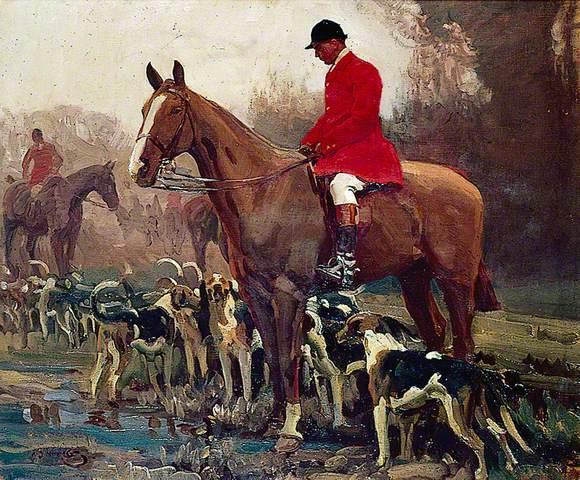
|
The Huntsman and HoundsOil on canvas
|
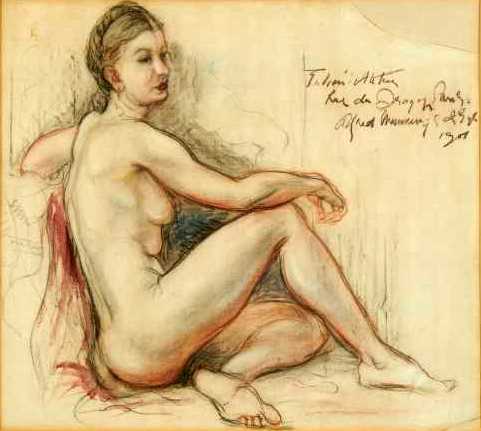
|
A Seated Female NudePencil, charcoal and coloured chalks
|
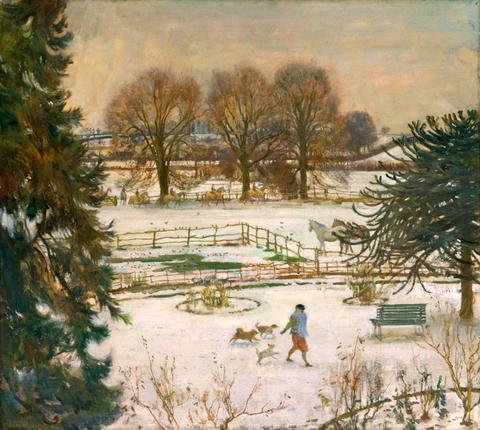
|
From my Bedroom WindowOil on canvas
|
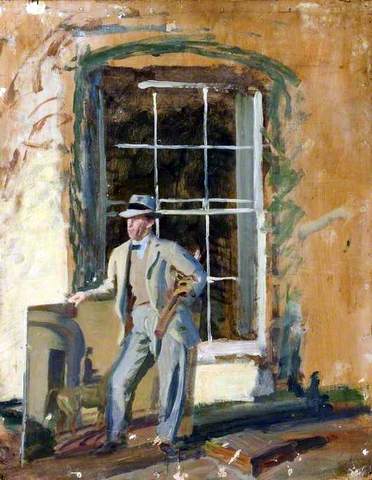
|
Self Portrait |
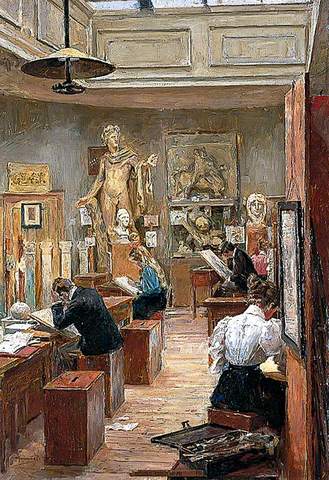
|
The Painting Room, Norwich School of ArtOil on canvas
|
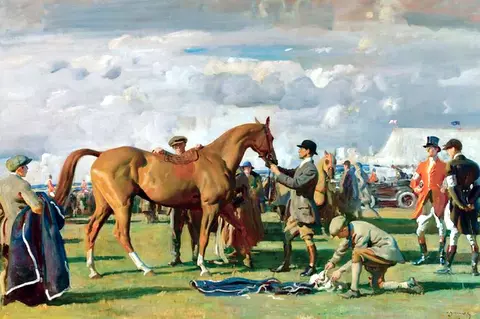
|
The Red Prince MareOil on canvas
|
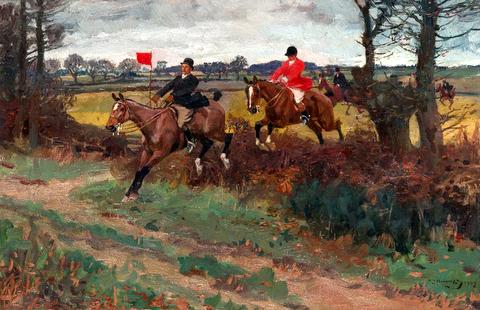
|
The Norwich Staghounds' Point-to-Point, 1902Oil on canvas
|
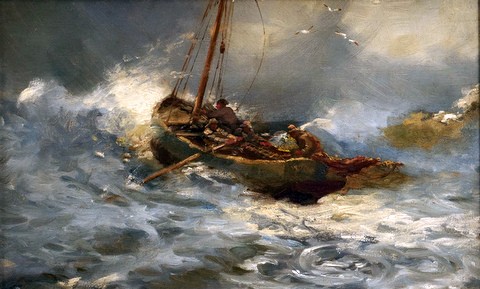
|
Launching a Boat off the BeachOil on canvas
|